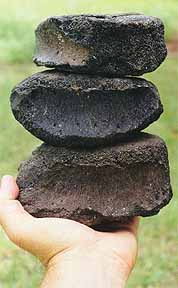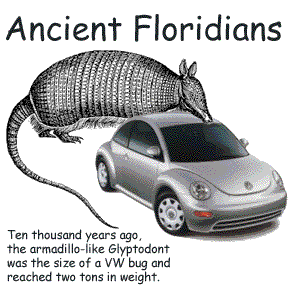
Ever wonder how the peninsula of Florida was formed? About 200 million years ago, North America and Africa slowly moved toward each other and eventually collided. If you look at a map of the world, you can see how the two continents actually fit together like a jigsaw puzzle. Then they gradually began to separate again, and as they did, a small piece of Africa broke off. It eventually became the crust of Florida, hidden beneath the ocean.
state was adding more layers to its crust. Billions of tiny sea creatures, many of them so small you would need a microscope to see them, lived and then died, and their exo-skeletons kept piling up. Miles and miles of beach sand was also washed around by the ocean's currents and added even more layers to the crust until finally, about 30 million years ago, there was enough land for animals to walk on. The layers where filled with both history from animals and humans. Fossils, beads, and even very basic ceramic wedding bands could be found by archaeologists. Florida's first residents were not people, they were animals like horses and camels and llamas. Some of the horses were only a few feet high at the shoulders. Eventually, these tiny horses may have had a not-so-nice neighbor named Titanis walleri. Titanis wasn't as friendly as Big Bird on Sesame Street. It couldn't fly and may have stood as tall as the Chicago Bull's Dennis Rodman. In short bursts of speed upwards of 50 mph, it would have no problem chasing the little horses for its supper. If the bird was alive today and could talk, its first words may very well have been, "Here kitty, kitty!" Another strange animal that moved into Florida was an armadillo as big as your dining room table. It weighed as much as a small car. And the camels I mentioned had no humps, plus we had rhinoceroses without horns, tortoises with six foot shells, fierce saber-toothed cats, jaguars and vultures with 15 foot wing spans. An animal called a sloth, looked like a bear with a tail and he was as tall as the top of your house's roof. Out in the ocean, we had whales 65 feet long that looked like huge snakes. We also had a cousin to today's manatee called a dugong. Some of them had tusks like a walrus, which they used to dig up grasses to eat on the ocean floor. Mammoths and mastodons were common residents and they looked a lot like today's elephants with big feet and long trunks and tusks. The mammoths would wander through fields to graze on the grasses like cows do today. Mastodons visited the forests and ate the leaves off tree branches. They were big and heavy animals, weighing as much as an entire professional football team. But they weren't covered with wool-like hair because it was too warm here.
At approximately 35 feet above sea level, Lehigh Acres where I live is the tallest natural strip of land in Lee County. When the rest of the county was covered by a shallow sea, Lehigh and Immokalee may have been islands. As you drive inland to other parts of Florida, you may notice white beach sand when you are no where near the ocean. That beach sand is from one of the many times Florida was covered with ocean. Where are the mammoths and mastodons today? What happened to the camels that lived here? Why are they only found in places like the Mid-East today? What about the tiny little horses and the armadillos as big as a car? Where are the sloths, the jaguars and saber-toothed cats? They all seem to have disappeared in Florida about 10,000 to 12,000 years ago. No one knows for sure what happened to them. But some scientists have a pretty good idea. First, there may have been a long period in which the weather worldwide began to get cooler quickly, rather than over thousands of years. The colder temperatures killed certain animals that weren't used to the cold and couldn't adjust to it. The cold also killed a lot of plants and trees and when that happened there was less food for animals such as mammoths and mastodons, sloths, camels and horses to eat. That made them easier to hunt, although we don't know who hunted them more: humans or other large carnivores. As these big animals began to die off, so did the animals that hunted them for food, such as the saber-toothed cat and American lion. Mark Renz is a Lehigh Acres native who guides people on day-trips into the Everglades or to area fossil hot spots. |


